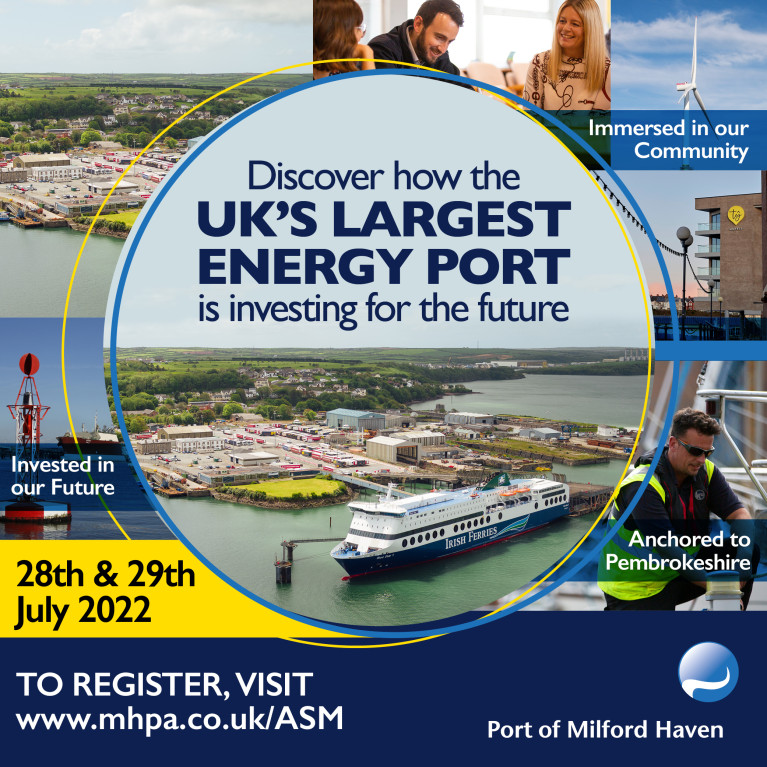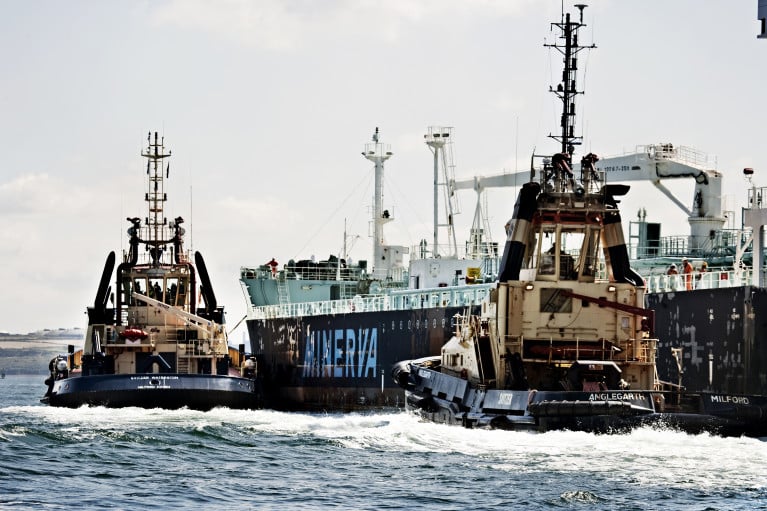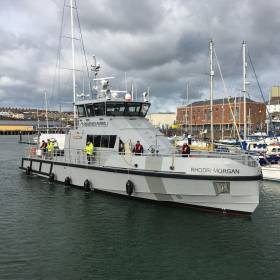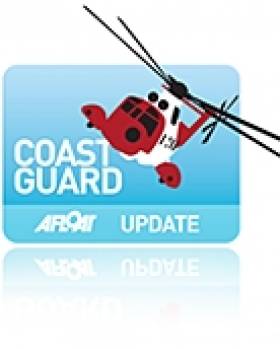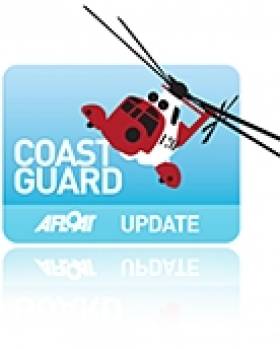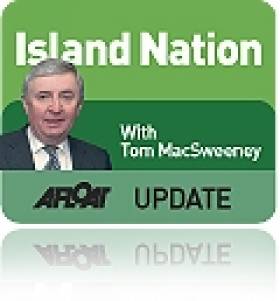Displaying items by tag: Milford Haven
Port of Milford Haven, Wales to Hold Annual Stakeholder Meetings to Engage with Local Community
In south Wales, the Port of Milford Haven is to host two Annual Stakeholder Meetings this year so to update members of the community on its latest developments and listen to feedback from the public.
Tom Sawyer, the Port’s new Chief Executive who joined in April, along with Chair, Chris Martin, will provide an overview on the organisation’s performance and vision, as well as updates on projects such as Pembroke Dock Marine, Milford Waterfront and its core business - servicing shipping on the Waterway.
Tom commented “I’m looking forward to meeting our stakeholders, many of whom I won’t have come across yet, in Pembroke Dock and Milford Haven. The sessions are a chance for the public to hear about what has been happening at the Port over the past year as we start to recover from the effects of Covid, but also about how our plans for future growth are progressing.”
He continued “One area I’d welcome feedback on is how we can do more to help our local community in a time when the cost of living is increasing and having a huge impact on peoples’ daily lives. We want to help where we can and understanding the extent of the problem is the first step towards addressing this.”
The events take place on:
Thursday 28th July at the Pater Hall, Pembroke Dock, 4.30-6.30pm
Friday 29th July at the Pill Social Centre, Milford Haven, 3-5pm
To register please email: [email protected] or call 01646 696100 and specify which date you would prefer, along with any questions you would like to ask the team.
There will also be an opportunity to join the meetings online (visit: www.mhpa.co.uk/ASM for more details).
Global tug provider Svitzer will strengthen it's UK fleet and emergency towing capabilities in the south Wales Port of Milford Haven with a newly reaquired tug, while freeing up another to support its London operations (see related story).
Svitzer, which is part of the Danish giant A.P. Moller-Maersk, has announced the purchase of a Svitzer Pembroke to support (tanker story) terminal operations in Milford Haven, UK.
The addition of the Svitzer Pembroke to the UK fleet will free up the 86-tonne bollard pull ASD tug Svitzer Ramsey for relocation to London to cater for expected growth at the River Thames and River Medway.
The Svitzer Pembroke was originally built for Svitzer at Zamakona Shipyard, Spain, but in 2014 the vessel was sold, and has operated under the name Boa Odin for the past eight years. The 100-tonne bollard-pull ASD tug has both aft towing winch and firefighting capabilities. This makes the Svitzer Pembroke uniquely suited to supporting Svitzer’s Terminal activities at Milford Haven and strengthens the existing fleet’s emergency response capability.
The arrival of the Svitzer Pembroke in Milford Haven allows Svitzer to redeploy the Svitzer Ramsey to London, where escort tugs with bollard pull from 80 tonnes and upward, plus fire fighting capabilities, are becoming increasingly important for serving customers effectively on River Thames and River Medway.
Commenting on the acquisition, Kasper Karlsen, Chief Operating Officer, Svitzer Europe and interim head of Svitzer in the UK said: “With the purchase of Svitzer Pembroke, we simultaneously accomplish two key goals. Increasing our minimum 80 tonnes bollard pull fleet in London from 6 to 7 tugs allows us to better meet current and future customer demands there. At the same time, we are able to strengthen our ability to provide emergency services and towing at Milford Haven. We are very pleased to once again have Svitzer Pembroke in our fleet.”
The newly reacquired tug has already arrived in the UK and will return to service in the coming months.
Svitzer currently operates more than 70 tugs in the UK and has around 650 employees.
The UK has been the launching off point for the company’s EcoTow project, with Svitzer’s entire fleet London, Felixstowe, Southampton and Scotland switching to low carbon biofuels. The service is set to be rolled out across the remaining ports in the UK and across Svitzer’s global operations.
Welsh Port’s Scholarship Scheme Opens for Pembrokeshire University Students
Port scholarships for university students from Pembrokeshire, south Wales are being encouraged for them to apply to the Port of Milford Haven’s scholarship scheme.
The annual initiative offers undergraduate students the chance to apply for an award of £1,500, as well as a work placement at the UK’s largest energy port. To be eligible, applicants must have spent the majority of their secondary education in Pembrokeshire and be enrolled on an undergraduate course at a British university.
Sitting on the judging panel this year are Chris Martin, Chair of the Port of Milford Haven; Maxine Thomas, Designated Senior Lead for Safeguarding and Learner Wellbeing at Pembrokeshire College and Jane Harries, Headteacher at Haverfordwest High VC School. Interviews will take place with the shortlisted applicants in December.
Over seventy undergraduates have been awarded scholarships by the Port in a wide range of subjects since the scheme was launched in 2003 including engineering, nutrition, law and history.
Chris Martin, Chair at the Port, is looking forward to receiving this year’s applications:
“I am delighted to be part of the panel again. The standard of applications that we receive is consistently high, so much so that we awarded five scholarships instead of the usual four last year! In addition to the financial support that’s provided, we find that the placement offers huge benefits as the students are based in a real working environment assigned to meaningful projects that will hold them in good stead for the future.”
For more information and to submit an application please visit this link here.
Rosslare-Fishguard Ferry Arrives to Welsh Port Where Cruiseship Total Doubles At Short Notice
On Monday of last week Afloat tracked a ferry arriving in the Port of Fishguard, Wales where two cruiseships one scheduled the other totally unexpected called to the scenic north Pembrokeshire port, writes Jehan Ashmore.
The ferry Stena Nordica (deputising for 'Europe') had departed Rosslare Harbour on a routine crossing of the St. Georges Channel to the Port of Fishguard is operated by Stena Line Ports. On arrival of the ferry into Fishguard Bay was the scene involving a pair of anchored cruiseships, one within the harbour while the other was offshore of the port's breakwater.
Of the pair, Aidavita was the scheduled caller to the Welsh port which was visited by the German operated cruiseship. The 1,266 passenger ship had previously arrived in the port at around dawn having made an overnight passage through the Irish Sea from Greenock, Scotland.
As for the second surprise ship, this was Seabourn Quest which departed the Bristol Channel from Portbury. The 450 guest cruiseship however did not call to another Welsh port as intended. The port been Milford Haven located in the south of Pembrokeshire.
Instead, Afloat noted the twin funnelled cruiseship took a course along the stunning rugged Pembrokeshire National Coastal Park to include taking a passage between the mainland and Skokholm Island. In addition while en route to Fishguard, the ship past Skomer Island.
The reason for the none show of the high-end luxury cruiseship was not due to operator Seabourn Cruise Line but the Milford Haven Port Authority which operates the Port of Milford Haven. The port is the UK's largest energy port and is capable of delivering 30% of the nation's gas demand.
In response to Afloat as to the reason for Seabourn Quest none show a spokesperson for the Port of Milford Haven commented: "We were extremely disappointed that Seabourn Quest was unable to call to Milford Haven. Unlike many Ports, at Milford Haven the tugs are not contracted to the Port but to our (energy) terminal customers and, on rare occasions, this does have the potential to impact on cruise calls as it did".
The Port added "that ultimately, the terminals will decide whether to release a tug for a cruise vessel based on their shipping requirements and the Port has to accept the decisions made. While this is the first time for many years that this situation has arisen, it clearly can occur.
So what was one port's loss was a gain for a neighbouring port on either side of the Welsh west coast region.
Seabourn Quest's unexpected call to Fishguard was a welcome boost to the port and the local economy. Reception teams organised by the Fishguard Bay Welcome (Tourism Information Centre) greeted passengers and crew ashore from tenders of both Aidavita and Seabourn Quest.
A more recent visitor took place last Friday when the mini superyacht like Variety Voyager made an appearance. The diminutive cruiseship operated by Variety Cruises has a capacity for just 71 guests.
Largest Fishing Port In Wales Welcomes FPV Rhodri Morgan
#fishing - The largest fishing port in Wales, at Milford Marina has welcomed the FPV Rhodri Morgan, one of five new fisheries patrol vessels taking to the waters in 2019.
The vessel was built by local company Mainstay Marine Solutions, and was named in Cardiff Bay in December, memorialising the former First Minister Rhodri Morgan.
At 26 metres long, weighing 75 tons, the vessel carries 11,000 litres of fuel. It also has room for a 6.5 metre sea-boat. It was built, along with four other vessels, to replace the previous fleet. This fleet will patrol Welsh waters looking for illegal fishing activity.
Melanie Durney, Docks and Marina Manager, Milford Marina, commented: “As Wales’ largest fishing port, we are honoured to have the FPV Rhodri Morgan here in the marina. It is an impressive vessel, and we are pleased to see that it will be part of the fleet patrolling the Welsh fishing grounds.”
The marina which is on the Milford Haven estuary is where the Port of Milford Haven is the UK’s top energy port and Wales’ busiest port handling around 20% of Britain’s seaborne trade in oil and gas. It is widely recognised in the industry as the energy capital of the UK in addition to a ferryport in Pembroke where Irish Ferries operate to Rosslare Harbour.
Port of Milford Haven, Wales Recognised As An Investor In People
#Ports&Shipping - The UK’s largest energy port, the Port of Milford Haven in south Wales, has been awarded accreditation against the Investors in People Standard, demonstrating its commitment to high performance through good people management.
The Port (this year celebrates its 60th year), employs 181 staff at all levels within the diverse range of industries it serves. As well as being well known for its role in the global oil and gas industry, the Port has a Four Gold Anchor marina, is home to the largest fishing port in Wales and is involved in the ferry (see related coverage), cruise, general cargo, renewables and tourism sectors.
Investors in People is the international standard for people management, defining what it takes to lead, support and manage people effectively to achieve sustainable results. Underpinning the Standard is the Investors in People framework, reflecting the latest workplace trends, essential skills and effective structures required to outperform in any industry. Investors in People enables organisations to benchmark against the best in the business on an international scale.
Paul Devoy, Head of Investors in People, said: “We’d like to congratulate the Port of Milford Haven; Investors in People accreditation is the sign of a great employer, an outperforming place to work and a clear commitment to success. The Port should be extremely proud of their achievement.”
Commenting on the award Vidette Swales, HR Director at the Port of Milford Haven, said “We dedicate a great deal of time and effort to ensuring we provide a safe yet dynamic environment to work in. Employees are encouraged to embrace our core values of safety, collaboration and excellence in everything that they do and many take this to another level by regularly going the extra mile and getting involved in various committees and events. We are pleased to have retained IIP accreditation since 2004 – made possible by the passion and commitment shown by staff on a daily basis.”
For more information about Investors in People please visit: www.investorsinpeople.com
Milford Haven Fisherman Missing After Falling Overboard
There was three crew onboard and they had finished fishing and were heading back to Milford. One of the crewmen was determined to be missing one hour after being last seen by the other two crew.
The fisherman, who was of Latvian origin, was not wearing a life jacket.
Milford Haven MRCC initiated a mayday relay broadcast to secure any assistance from other vessels that may be in the immediate area.
They called out Coastguard rescue teams from Dale and Broad Haven and requested the launch of Angle and St David's RNLI lifeboats and inshore lifeboat. A rescue helicopter was also requested.
A search has been undertaken today by these SAR units and fourteen other vessels of different types. The search has now been terminated.
Nigel Yelland, Watch Manager, Milford Haven, said:
An extensive search has been undertaken by many vessels in the hope of finding this missing fisherman. Unfortunately, he was not wearing a lifejacket, which could have aided in his survivability in this incident.
The Return of the 'Wexford' Tall-Ship
A grant of €1m from Fáilte Ireland was allocated towards the cost of the refit as part of the National Development Plan (NDP). Visitors can now take guided tours of the floating tourist attraction though access to the shoreside visitor centre remains closed due to an upgrade. Work on an extension of a new exhibition centre is expected to be completed in May or June.
Dunbrody is a full scale reconstruction of the 19th century replica famine-ship based on the vessel built in 1845 in Quebec, Canada for the Graves family of New Ross. Ireland's most inland port being made famous with the visit of President John F. Kennedy in 1963 to the same quayside where Dunbrody is berthed.
To date the Dunbrody's presence outside her homeport has been scarce. During the Waterford Tall Ships Festival in 2005 she took part in a memorable and historic 'Parade of Sail' where she formed as part of the trio of Irish tall ships that met together for the only time. The sailing spectacle of the international fleet was headed firstly by the Irish trio with Asgard II leading followed by Dunbrody and astern the Jeanie Johnston.
In the following year Dunbrody made her maiden and only international voyage to Milford Haven in south Wales. The Pembrokeshire estuary had hosted the new festival, Seafair Haven. On that occasion she had the honour of leading another parade of sail, under the command of Captain Tom McCarthy.
Dunbrody was last dry-docked in 2006 and also at the New Ross boatyard which lies on the Co. Kilkenny side of the riverbank. The 176 foot / 54 metre barque was built in 2001 and was last vessel completed at the boatyard. During her building the public could access the yard and the construction process could be viewed from above at a gallery set within the covered building hall.
The structure no longer exists but which was built originally for the Ross Company boatyard during the 1970's. The yard specialised in building barge pontoons for markets in the North Sea until the premises closed in the 1980's. In recent years and under new management the dry-dock (75m X 15m) has been upgraded with a new gate and pump.
Looking for further reading on Tall Ships in Ireland? Click the links below:
Click this link to read all our Tall Ships Stories on one handy page
Previewing Ireland's Tall Ships 2011 Season
Can Ireland Get a New Tall Ship?
- Asgard II
- Jeanie Johnston
- river barrow
- New Ross
- River Suir
- Milford Haven
- Ports and Shipping News
- barque
- Fáilte Ireland
- Dunbrody
- Parade of Sail
- Brigantine
- Waterford Tall Ships Festival
- Dunbrody Heritage Centre
- River Nore
- New Ross Boat Yard
- Sea Haven
- National Development Plan
- NDP
- President John F. Kennedy
- Capt. Tom McCarthy
- Ross Company
- Seafair Haven
Woman Airlifted to Cliff Top
The woman who is not local to the area was walking with her 10 and 17 year old sons and had climbed some rocks near the caravan park but had become stuck. The children had managed to scramble to the top of the cliffs and raise the alarm. They were unable to help their mother.
The weather this afternoon has been south westerly winds force 5 – 7 with occasional rain with low visibility.
The Tenby Coastguard Rescue Team which has a cliff capability, and Tenby RNLI all weather lifeboat with its 'Y' boat was asked to turn out, and the Coastguard Sector Manager for Pembroke also attended. The RNLI inshore lifeboat was also launched.
Due to the prevailing weather and surf conditions a rescue helicopter – Rescue 169 - from RAF Chivenor was also scrambled.
Bob Peel, Coastguard Watch manager at Milford haven Coastguard said
"Once the woman's location had been determined and a Coastguard lowered to her on the rocks it was agreed amongst all the rescuing parties that with the 2 lifeboat crewmen and 1 cliff man from the Coastguard with the woman, it was probably too dangerous to evacuate everyone by boat.
"There is dense gorse and blackthorn at the top of the cliff is and it would have proved difficult to recover her safely for the cliff team, so the rescue helicopter was requested. By 4.00 pm the helicopter crew were winching the female and Coastguard up from the base of the cliff whilst the two crewmen returned to the all weather lifeboat by their Y boat. The woman was cold and shaken and had no need of medical attention.
"This is a salutary lesson in making sure that if you are in unknown terrain without the suitable climbing gear please don't attempt slippery cliff and rock faces, as inevitably rocky terrain can catch the unprepared out very quickly."
Could Waterford Lead a Tall Ships Revival?
I am aware that a number of groups are examining the possibility of launching a national sail training programme. I wonder if Waterford could be the place to lead it and be the base for national sail training. The marine sector suffers from the neglect and disregard of a disinterested Government so any revival will have to be outside of State support.
Waterford staged a hugely successful visit of the Tall Ships Race in 2005 and has been honoured with the hosting of the Race start next year. Bertie Ahern as Taoiseach snubbed the Race visit in 2005. It showed how little respect he had for the maritime sector. Half-a-million people visited the city, but Bertie couldn't be bothered to do so.
The city has been encouraging young people to get experience of crewing aboard Tall Ships. Twenty-year-old David Murray, a business information systems student at University College Cork, is becoming a sail training "veteran" through experience gained over the past two years.
He first 'shipped out' last year aboard the Tenacious operated by the Jubilee Sailing Trust of the UK, a registered charity which also operates the Lord Nelson. His first voyage, following which he sailed the north coast of Scotland on the Lord Nelson and this year became a Bosun's Mate, taking more responsibility aboard the Nelson on a voyage from Southampton to Glasgow. Then he joined the Dutch three-masted schooner, Eendracht, from Kristiansand in Norway to Hartlepool in the UK, where he disembarked and re-joined the Tenacious, again as Bosun's Mate, sailing to Bruges in Belgium and onto London. A few days later he was back aboard the Lord Nelson as Bosun's Mate from Falmouth to Milford Haven in Wales and then to Waterford, from where the Tall Ships Race will start next year,
"It's been a brilliant experience. I've met a great mix of people. Sail training is for everyone," he said. "It's been a very busy but great couple of summers with Tall Ships and I'm really looking forward to next year, especially with Waterford again hosting the fleet and crews from around the world coming to the city. I strongly recommend sail training and the fact that the races start from Waterford next summer makes it even easier for Irish young people to get involved."
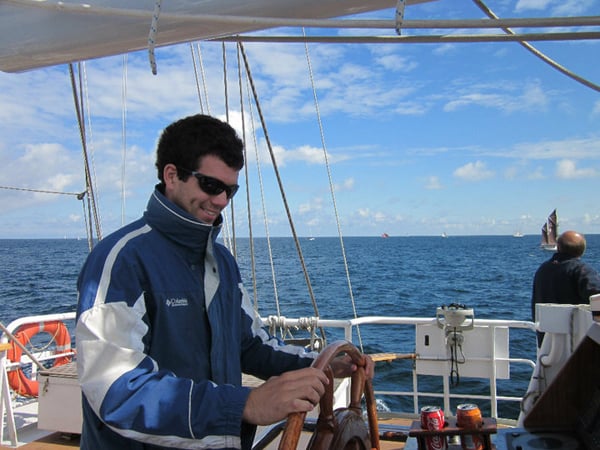
David Murray is a Tall Ships veteran at the age of 20
David comes from Butlerstown in Waterford. His pleasure in the experience of tall ship sailing underlines what has been lost by the shameful behaviour of the Government in closing down the sail training programme.
It will be a national disgrace if there is not an Irish tall ship flying the Tricolour at next year's Tall Ships Race start in Waterford. The city has done magnificent work in putting Ireland to the forefront in the world of tall ships. Perhaps Waterford should be the base for the creation of a new national sail training system.
• This article is reprinted by permission of the EVENING ECHO of Cork where Tom MacSweeney writes maritime columns twice weekly. Evening Echo website: www.eecho.ie





























